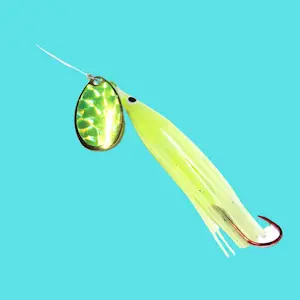Trolling Rigs For Trout Fishing (The 3 Best Setups)
UPDATED 03 NOVEMBER 2023
by Robert Ceran
Trolling for trout has become increasingly popular, as it provides one of the most efficient methods for covering lots of water in search of hungry trout, and regularly outperforms other fishing tactics on lakes and ponds.
However, in order to succeed with trout trolling, it’s essential to use the right rigs, and fish them in the right way.
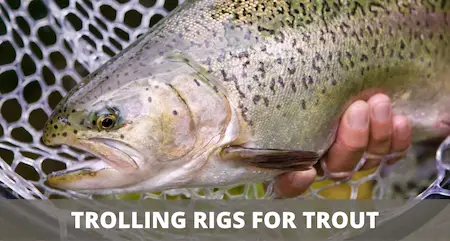
In this article I’ll discuss the top 3 trolling rigs for trout, and will also cover how to use them correctly.
How do you rig for trolling trout?
The three best trout trolling rigs are:
- Trolling rig with inline weight
- 3 way rig
- Flasher rig for trout
Each of these trout rigs comes with its own pros and cons, and which one of these is best for you depends on the conditions that you’ll be fishing in.
In general it’s better to keep your rigging as simple as possible, unless you need a specific feature that is only available when using a more complex rig.
Now let’s look at these 3 rigs in detail, and discuss what each of them is ideally suited for, so you can decide which one is right for you.
Trolling rig with inline weight
This is the simplest trolling rig for trout, and works very well for trout trolling in small to medium sized lakes and ponds, where trout are found in relatively shallow water.
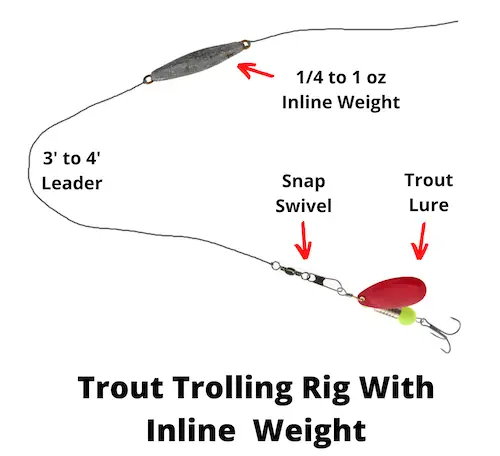
It also works well any time when you know that trout are feeding close to the surface.
Tying this rig is very simple. Start by tying your main line to a 1/4 to 1 oz inline weight with barrel swivels at both ends.
If your weight doesn’t have swivels built into it, it’s better to tie a snap swivel to your main line, and then attach that to the weight.
It’s really important to have at least one swivel in your trout setup, since trolling lures tend to twist up your line a lot.
Next, attach a 3 to 4 foot fluorocarbon leader to the inline weight, and then tie your lure to the other end of the leader.
Most trout anglers prefer to use some kind of spinner for trolling (popular ones include wedding ring, kokanee spinners, panther martins, and rooster tails).
However, you can actually use any other type of lure as well, and small spoons tend to produce a lot of bites as well.
3 way rig
The 3 way rig is a classic rig that’s great for trout trolling and allows you to use heavy weights to get you rig down into deeper water.
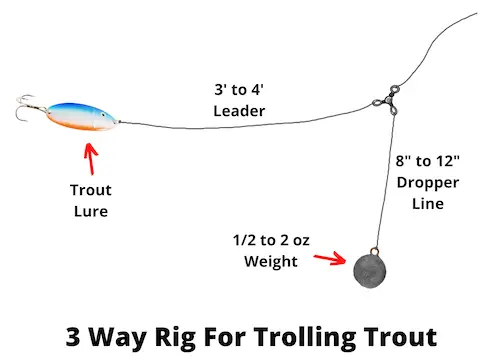
The key advantage of the 3 way rig is that you can attach your weight with a dropper line that’s weaker than the main line, so if the weight gets snagged on the bottom, you can break off the dropper line, which allows you to keep the rest of your rig intact.
To tie the 3 way swivel rig, start by tying your main line to a 3 way swivel, and then attach a 1 foot dropper line to one of the other eyes of the 3 way swivel.
Next, tie the dropper line to a 1/2 to 2 oz weight. The important thing to remember is that your dropper line should be about half the pound test weight of your main line.
Similar to the previous rig, you can use any trout lure with this rig, though the most popular ones are spinners and spoons.
Trout flasher rig
While flashers are most commonly used for salmon rigs for trolling, they can also work very well for trout, though many trout anglers prefer to use dodgers instead of flashers (more on that below).
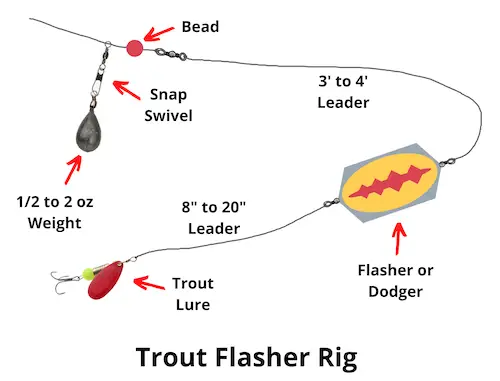
The principle of a flasher is to use an extra large metallic or colored blade that spins in the water and thereby creates flashes of light to attract trout from far away.
In most cases, the business end of the rig with your lure is about 8 to 20 inches behind the flasher (or dodger).
To tie a flasher rig, start by threading a snap swivel on to your main trout fishing line, and then tie the main line onto a barrel swivel.
Next, attach a 1/2 to 2 oz weight to the snap swivel (the great thing about using a snap swivel for this trout trolling setup is that you can easily change the weight any time).
Next, tie a 1 to 2 foot leader to the barrel swivel, and tie the other end to your flasher. Finally, tie a 8 to 20 inch leader to the other side of the flasher, and then tie that to your lure.
In general, it’s best to use snap swivels whenever possible, as that will allow you to quickly change any part of your trout trolling setup.
Flasher vs dodger – which is better for your trout trolling setup?
While flashers and dodgers look quite similar, there are two key differences between them.
First of all, flashers are designed to spin in the water, while dodgers are designed to wobble, which produces a different attraction signal for trout, and also has a different effect on the movement of your lure trailing behind them.
Secondly, dodgers perform better at slower trolling speeds, while flashers perform better at higher trolling speeds.
And since trout are usually caught with slower trolling speeds, dodgers tend to be the better choice for trout.
Trolling for trout with downriggers
Downriggers are the most effective way to target deep water trout in more than 30 feet of depth.
This strategy is most often used for lake trout trolling, since lakers like to hold in water that’s at least 60 to 100 foot deep during the summer.
Downriggers consist of a heavy lead ball (usually around 10 lb) that is lowered on a heavy line that comes with its own spool.
You start by attaching your trolling rig to the downrigger weight with a release clip, and then lower the downrigger weight to the desired depth.
Once at the right depth, you troll your rig and wait for a fish to bite. When a trout eats the bait, it pulls your line out of the line release clip, and you can then fight the fish and land it with your rod and reel.
In order to use downriggers, you need to use a relatively long and heavy fiberglass rod, since the downrigger weight bends the rod tip all the way down to the water. A graphite trout rod can snap from this kind of strain.
The best rig to use with a downrigger is the flasher rig (but without the weight). But since the trolling speed for lake trout is slower than for salmon, it’s often better to use a dodger instead of a flasher.
Trolling for trout without downriggers
Even without resorting to a downrigger, you can reach 25 to 30 feet of trolling depth simply by using heavy lead weights and letting out more line from your reel.
This is usually deep enough to target rainbow trout, which rarely hold deeper than that. In order to find the right depth, it’s best to use a fish finder to find groups of trout.
You can use trolling depth charts to estimate the depth at which your rig is presented when using a defined amount of weight while letting out a defined length of line.
The easiest way to measure the length of line that you release is by using a line counter reel, which is a must have if you plan to do a lot of trout trolling.
Finally, if you’re going to be trolling for trout in smaller lakes and ponds, you don’t need to worry about reaching deeper water layers, since trout are usually found in less than 20 feet of water in these smaller lakes.
Trout trolling setup with divers
Another option to get your trout trolling rig down to greater depths is to use a trolling diver (such as the Dipsy Diver or Jet Diver).
These devices are built to use water resistance to dive down in the water with your line attached – a mechanism that in some ways resembles that of deep diving crankbaits.
In fact, a great option is to run an actual deep diving crankbait 2 to 4 feet behind your diver.
This combination can dive down to depths of up to 25 feet without the help of weights or a downrigger, and this is plenty deep enough to troll for rainbow trout in many lakes.
Trolling for stocked trout
If you’re trolling for stocked trout in your local pond or lake, chances are that they are going to be active in more shallow waters, ranging from just below the surface down to about 25 feet.
That means you can reach these fish without having to use a downrigger, and in most cases a simple trolling rig with an inline weight will do the trick.
In fact, if you notice that trout are feeding close to the surface, you can even troll for them with just a few split shot weights added to weigh down your lure.

